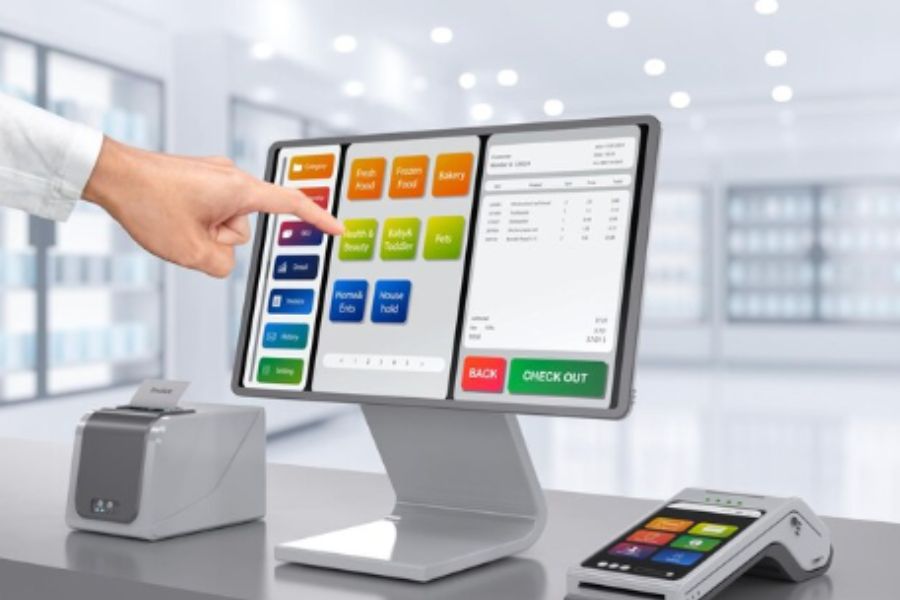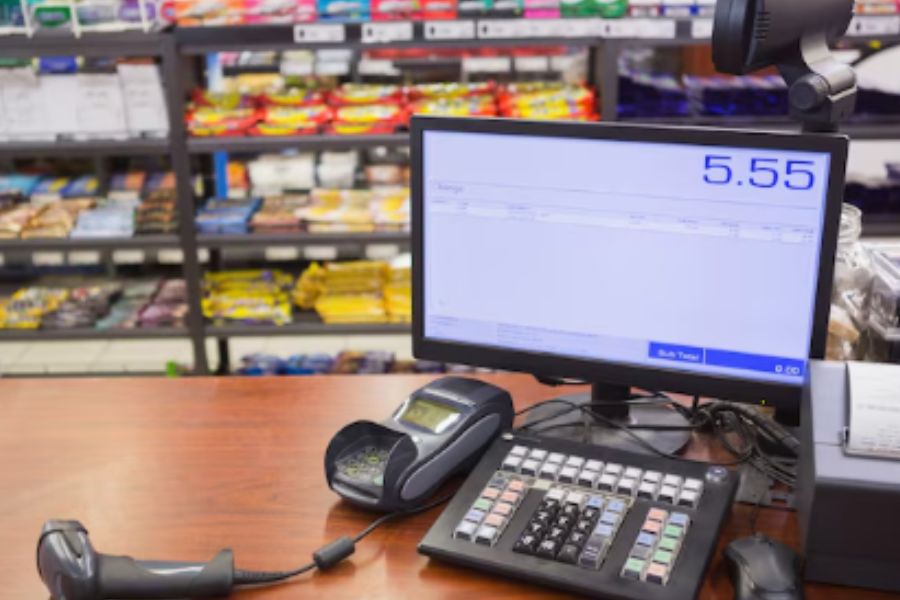Are you maximizing the potential of your jewelry point of sale system? In a competitive market, efficiency and effectiveness are key. That’s why we’ve given you these 10 essential practices to help you make the most of your system. Are you ready to elevate your jewelry business to the next level? Now, let’s explore us in this blog below!
Overview of Jewelry Point of Sale System
A jewelry point of sale system (or jewelry POS) is a specialized software solution designed to meet the unique needs of jewelry retailers. It serves as a central hub for managing various aspects of a jewelry store’s operations, from sales transactions to inventory management.
At its core, a jewelry POS system functions much like a traditional POS system, enabling retailers to process sales transactions quickly and efficiently. However, it also includes features and functionalities tailored specifically for the jewelry industry, such as the ability to track intricate details about individual pieces, manage gemstone characteristics, and handle complex pricing structures.
In addition to streamlining the sales process, this system provides valuable insights and analytics that can help retailers make informed business decisions. By tracking sales trends, monitoring inventory levels, and analyzing customer preferences, retailers can optimize their product offerings and pricing strategies to maximize profitability.
Overall, a jewelry point of sale system plays a crucial role in helping jewelry retailers manage their businesses effectively, providing the tools and insights needed to succeed in a competitive market.
10 Practices To Make The Most Out Of Your Jewelry Point Of Sale System
Running a successful jewelry store requires efficient management practices, especially when it comes to inventory and sales. Here are 10 strategies to maximize the potential of your jewelry point of sale system:
Use Inventory Management for Demand Forecasting
Embrace the power of inventory management within your jewelry POS system to ensure you maintain the right balance of stock. Analyze historical sales data and monitor current trends to forecast future demand accurately. Effective inventory tracking allows you to anticipate the need for product replenishment, especially for high-demand items.
For instance, if your sales data indicates a consistent increase in demand for diamond earrings during the festive season, you can prepare by boosting your inventory ahead of time. This approach not only prevents stockouts but also positions you to capitalize on peak selling periods, ensuring your customers always find what they’re looking for.
Invest in Jewelry Store Inventory Management Software
To truly harness the capabilities of inventory management in the jewelry business, investing in specialized jewelry store inventory management software is a must. This specialized POS software goes beyond mere inventory control; it streamlines billing, facilitates employee management, offers diverse payment options, and manages repairs and sales—all while elevating the customer experience.
Choosing a generic POS system might seem cost-efficient initially, but for long-term success and efficiency, a dedicated retail jewelry POS system is key.
Take ConnectPOS as an example, it is tailored to the intricacies of jewelry sales, including tracking unique items, managing certifications, and handling intricate transactions that generic systems often fail to address effectively.
Implement Visual Merchandising Strategies
Harness the power of visual merchandising to maximize the appeal of your jewelry inventory. By consistently updating and refreshing your product displays, you create an atmosphere of novelty and excitement, suggesting a constant influx of new pieces. This strategy not only draws customers in but also promotes the movement of older stock.
Incorporate visual merchandising into your inventory management strategy by using your POS system’s data to inform display choices. Place best-selling items in prime locations and rotate stock to maintain a dynamic store environment. An effective visual layout complements your inventory management by using space wisely, showcasing jewelry to its best advantage, and enhancing the customer’s journey through your store.
Remember, the right ambiance, lighting, and display cases are crucial in creating an enticing shopping experience that can lead to increased sales.
Regularly Refresh Your Jewelry Collection
To maintain a dynamic and attractive retail environment, it’s important to regularly evaluate and curate your jewelry collection. Phasing out pieces that haven’t sold and introducing new, trendy items will keep your store’s aesthetic current and entice customers to revisit frequently in anticipation of your latest offerings.
When it comes to older inventory that hasn’t moved, consider implementing promotional sales or discount events to encourage purchases. These initiatives can help you free up valuable display space for new arrivals while also providing your customers with attractive deals, creating a win-win situation.
Utilize Inventory Management During Peak Seasons
Effective inventory management is particularly crucial during peak seasons when sales volumes are at their highest. Seasons like Christmas, Valentine’s Day, and popular wedding months can significantly boost demand for jewelry. A well-structured inventory strategy is vital during these times to ensure that you have the right products in the right quantities.
Adjust your buying patterns to align with these seasonal trends by stocking up in anticipation of increased traffic and slowing down purchases when a lull in sales is expected. Utilize your jewelry inventory management software to generate detailed reports, helping you make data-driven decisions about stock levels across different departments.
By doing so, you’ll be better equipped to satisfy customer demand without the risk of overstocking or missed sales opportunities.
Streamline Warehouse Management
To elevate your jewelry storage and management, focus on the strategic organization of your warehouse space. It’s not the amount of space that matters, but how effectively you use it. Overextending your inventory across too many locations can lead to complications in tracking and data consolidation, hindering your operational efficiency.
Implementing a jewelry-specific POS system can help overcome these challenges. Such a system consolidates inventory data, making it accessible and manageable from a single point. Aim to balance your storage approach by avoiding underutilization of space or cluttering, which can hamper product accessibility.
A tailored POS system can provide powerful tools to optimize product stocking, ensuring a smooth and efficient warehouse operation.
Embrace Automation
Manual inventory management, such as using spreadsheets or paper records, is prone to errors and inefficiencies. These outdated methods can compromise accuracy and hinder productivity, ultimately affecting your bottom line and customer satisfaction.
Transition to a jewelry POS system like ConnectPOS, which offers robust inventory management to revolutionize how you track and handle stock. Such systems offer real-time updates and data accuracy, streamlining order management and fulfillment processes. With automation, you can also enhance your loyalty programs, making them more effective in retaining existing customers and attracting new ones.
Automated inventory management not only saves time but also provides valuable insights for making informed business decisions, propelling your jewelry store toward greater success.
Conduct Routine Audits
Regular inventory audits are essential for ensuring that your actual stock aligns with recorded data. Establish a routine for conducting these audits, with a comprehensive annual physical inventory count as a cornerstone activity. Although time-consuming, this process is critical for accurate record-keeping, taxation, and accounting.
Physical inventory checks can reveal discrepancies that might not be apparent through your POS system alone. These checks serve as a valuable feedback mechanism, allowing you to identify and rectify errors, make adjustments based on historical trends, and better prepare for future inventory challenges.
Adopt an Omnichannel Approach
Adopting an omnichannel approach revolutionizes the way businesses interact with customers by seamlessly integrating various sales channels. This unified approach ensures that customers enjoy the same level of service and convenience, regardless of how or where they choose to shop.
An omnichannel presence also helps build brand loyalty and increases customer satisfaction by delivering a consistent and personalized shopping journey. Use the data gathered across different platforms to tailor your marketing strategies and provide targeted recommendations and promotions that resonate with individual customer experiences.
Prioritize Labeling
The foundation of a well-managed jewelry inventory system is in the details of labeling. Before tagging your items, organize your products systematically. Assign distinct barcodes or RFID tags to each piece of jewelry, and categorize them based on type (e.g., rings, bracelets) and material (e.g., gold, silver).
This detailed systematization allows for quick and accurate location of items within your inventory, streamlines the checkout process, and simplifies stock management. Accurate labeling is essential for preventing sales and inventory discrepancies, facilitating easier merchandise tracking, and enhancing overall inventory control.
How to Find the Best Jewelry Point-of-Sale System?
When searching for the best jewelry point-of-sale system, several key features and considerations can help you make an informed decision.
Here’s a breakdown of what to look for:
- Repair, setting, and engraving work orders
A comprehensive jewelry POS system should excel in managing repair, setting, and engraving work orders efficiently. This entails a robust system that allows for seamless tracking of work orders from initiation to completion.
- Personalized tagging
Efficient inventory management is essential in the jewelry business, and personalized tagging plays a crucial role in this aspect. A top-notch POS system should offer customizable tagging options to categorize and label inventory items accurately.
- Handling special orders, deposits, and layaways
Jewelry purchases often involve special orders, deposits, and layaways, requiring a POS system with robust capabilities in managing such transactions. Seek a system that allows for seamless processing of special orders, flexible deposit options, and efficient handling of layaway plans.
- Management of non-barcoded items
In the jewelry industry, not all items come with barcodes, necessitating a POS system capable of managing non-barcoded items effectively. Look for features that enable manual entry of item details, such as description, metal type, gemstone specifications, and pricing, to ensure accurate inventory tracking and sales processing for all items in your catalog.
- Insurance-related inventory tracking
Tracking inventory for insurance purposes is vital in safeguarding your business against potential losses. A reliable POS system should offer robust features for insurance-related inventory tracking, including documentation of item details, valuation, and coverage information.
- Data integration capabilities
Integration with existing systems and software is essential for seamless data flow and efficient business operations. With robust data integration capabilities, allowing for seamless synchronization with accounting software, inventory management systems, customer relationship management (CRM POS) tools, and other relevant platforms.
- Integration options, extensions, and add-ons
Flexibility and scalability are key considerations when choosing a jewelry POS system. Opt for a system that offers integration options, extensions, and add-ons to tailor the solution to your specific needs and accommodate future growth.
Whether it’s additional features, third-party integrations, or customizations, a versatile POS system provides the flexibility to adapt to evolving business requirements and industry trends.
- Flexible help and support services
Reliable customer support is essential for ensuring smooth system implementation and ongoing maintenance. Choose a POS provider that offers responsive and knowledgeable help and support services to address any issues or questions that may arise.
Whether it’s technical assistance, training resources, or troubleshooting guidance, prompt and effective support enhances your overall experience with the POS system and minimizes disruptions to your business operations.
- Tracking sales sommissions
Effective sales commission tracking is vital for motivating your sales team and incentivizing performance. It offers robust features for tracking sales commissions accurately, including customizable commission structures, automated calculations, and detailed reporting capabilities.
FAQs: Jewelry Point of Sale System
- What are the benefits of using a jewelry POS system?
A jewelry POS system offers several benefits, including:
- Streamlined inventory management: Easily track and manage jewelry items, including repairs, special orders, and unique identifiers.
- Enhanced customer service: Provide personalized tagging, manage special orders and layaways, and track customer preferences for a better shopping experience.
- Improved sales tracking and reporting: Monitor sales performance, track commissions, and generate detailed reports to make informed business decisions.
- How can I ensure data security with my POS system?
To ensure data security with your jewelry POS system, consider the following measures:
- Choose a reputable POS provider with robust security features and compliance with industry standards.
- Implement strong access controls, such as unique user accounts and passwords, to restrict unauthorized access to sensitive data.
- Regularly update and patch your POS software to address security vulnerabilities and protect against cyber threats.
- Encrypt sensitive data, such as customer information and payment details, to prevent unauthorized interception or access.
- Train your staff on best practices for data security and monitor system activity for any suspicious or unauthorized behavior.
- Is it possible to integrate a POS system with my existing website?
Yes, many jewelry POS systems offer integration options to connect with existing websites or e-commerce platforms. Integration can streamline online and in-store operations, allowing for centralized inventory management, synchronized product listings, and seamless order processing. Consult with your POS provider to explore integration possibilities and ensure compatibility with your website platform.
Conclusion
In sum, implementing these 10 practices can significantly enhance the efficiency and effectiveness of your jewelry point of sale system. By prioritizing features such as repair and work order management, personalized tagging, and flexible handling of special orders, deposits, and layaways, you can streamline your operations and provide a seamless customer experience.
If you have any questions about ConnectPOS’s jewelry point-of-sale system, don’t hesitate to contact us.



